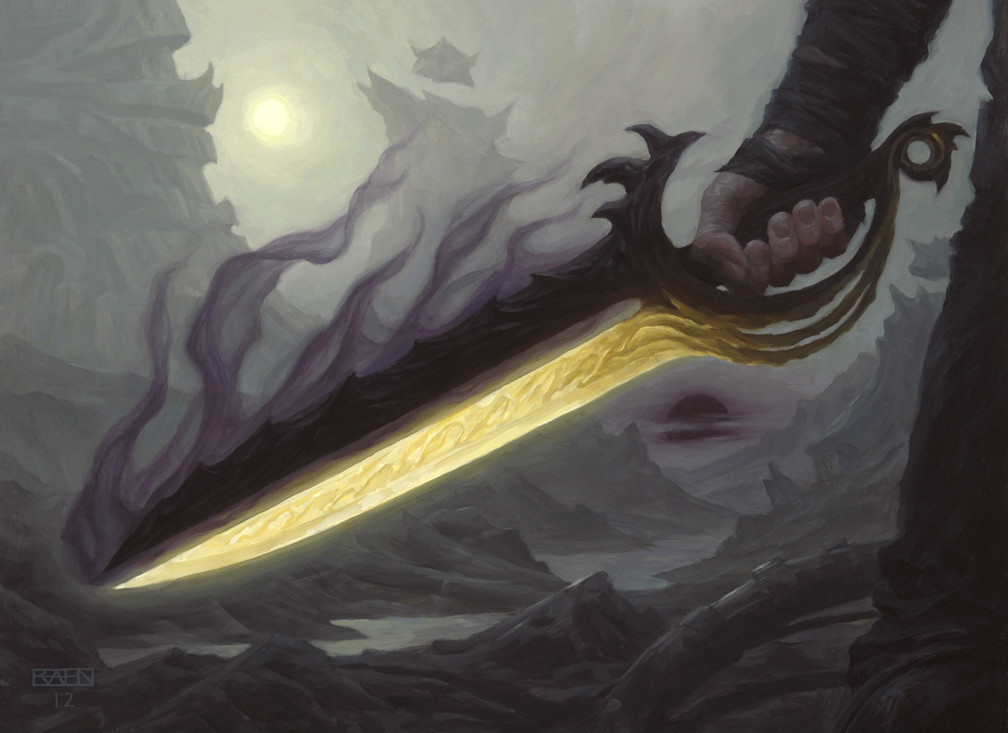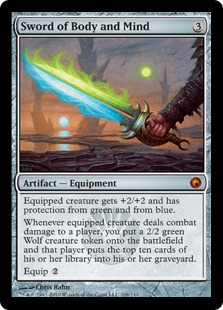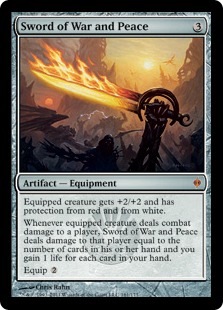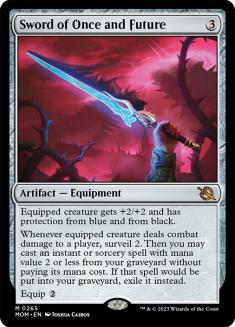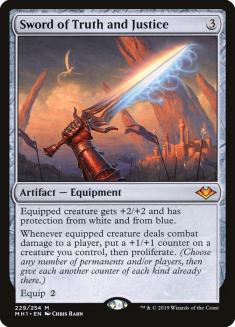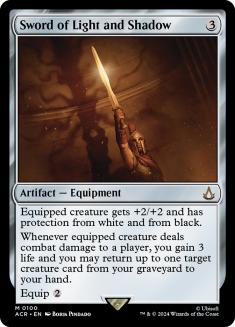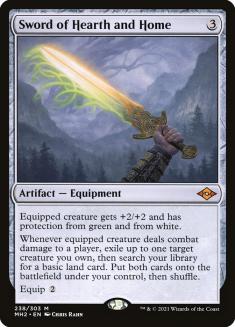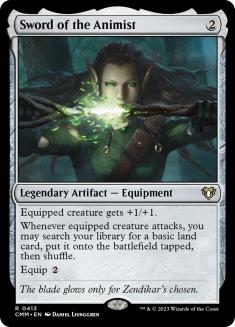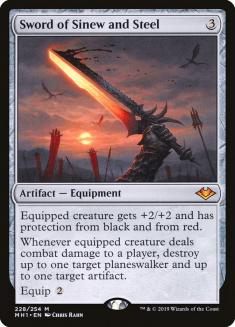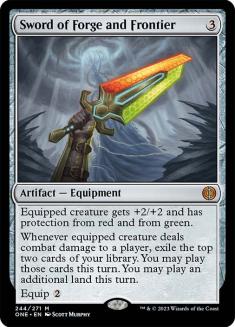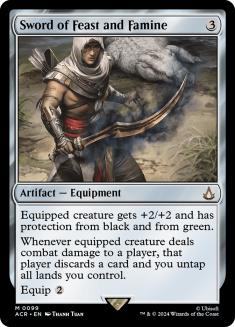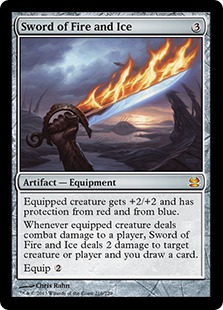Nearly twenty years ago, Equipment were introduced to Magic with the release of Mirrodin. The release of Darksteel shortly after would mark the beginning of one of the game’s most popular cycles, with the printings of Sword of Light and Shadow and Sword of Fire and Ice. March of the Machine has brought us the final entry of that cycle in Sword of Once and Future, and with the cycle now complete, I’d like to talk about these cards in terms of each’s individual relative Cube-worthiness.
I mentioned Sword of Once and Future in my Top 10 article for March of the Machine, but I don’t think that this sufficiently honored the printing. This is a cycle twenty years in the making! As such, I thought it would be fun to go over each entry in the cycle individually and rank them in terms of what they add to Cube gameplay. Before we get into that, though, I’d like to address protection as a mechanic.
Protection DEBT
Protection is among the least fun mechanics in Magic, and can lead to games where one player’s cards just don’t work at all. It can be reasonable in small doses, but the relevance of protection in the average game correlates with a lack of player agency.
The Sword cycle is actually one of the most engaging implementations of protection, given that you’ll often be able to just interact with the Sword itself. The startup cost of three mana with an additional two to equip isn’t the cheapest rate, and breaking that up over multiple turns telegraphs your intentions.
That said, the less efficient the removal options are in a given Cube, the less palatable these cards will be for that Cube’s gameplay. For medium- to high-power environments, though, these cards are beloved because they’re so fun to connect with. Just be mindful that the less it feels like a game to actually equip a creature and connect, the less fun these cards will be.
Now let’s get on to the rankings! We’ll start with the least Cube-worthy of the lot and work our way up to the most.
10. Sword of Body and Mind
Sword of Body and Mind occupies Cube space adjacent to Jace, Memory Adept. Milling ten cards at a time is just really unpleasant for 40-card formats. Sword of Body and Mind has more immediate interaction points and does involve additional cards and the ability to make a successful attack, but even still, it is the Sword that is most invested in just ending the game.
When I say that Sword of Body and Mind is the Sword most invested in ending the game, I do mean that it could go either way, because I can say from experience that milling ten cards is a pretty good way to lose to Yawgmoth’s Will! You’ll either be milling your opponent for about half of their library and making a blocker to stop them from killing you on the way back or giving them some avenue to win with graveyard resources, and either prospect leads to net fun for both players.
There’s definitely more room for Sword of Body and Mind in Cubes with unique rule sets that encourage larger decks, with Commander Cubes being the most prominent example that comes to mind. Mostly, Sword of Body and Mind is the sort of card that you’d only want to see in a Vintage Cube, and even then only barely. Locking this one in as the worst of the cycle for Cube was among the easier rankings on today’s list.
9. Sword of War and Peace
Sword of War and Peace is the other Sword that is most interested in ending the game, though to its credit it isn’t giving your opponent anything to try to win on the way back. That said, Sword of War and Peace is only offering life swings and doesn’t do anything that suggests you would be interested in playing more than one or two more turns. All of the other Swords have the potential to impact the battlefield in some way, and the one-dimensionality of Sword of War and Peace puts it firmly in contention for the least fun of the lot.
There is some merit in Sword of War and Peace for Cube play. If battlefields really get bogged down by Wall of Omens, Spirit tokens, and that sort of thing, then Sword of War and Peace can be a welcome breaker. That said, there is no entry in the cycle that I’ve left in my sideboard, even when I had Stoneforge Mystic in my deck, as often as Sword of War and Peace. It is the entry whose gameplay implications rest most on the relevance of the protections that it offers, and by extension it leads to some of the least fun games.
8. Sword of Once and Future
I wasn’t big on Sword of Once and Future last week, and I’m still not! I will at least grant that it’s trying to do something cool. Surveil 2 isn’t terribly relevant when you’re already connecting with an Equipment that gives +2/+2, but the idea is of course that it helps you find instant and sorceries to cast for free. Netting two free mana to cast a spell is a solid deal, though you’re really not getting your mana’s worth if you’re unsuccessful in accomplishing that goal. And that’s sort of the thing about Sword of Once and Future: you’re mostly playing Equipment in decks that are relatively long on creatures to equip. There will be room for some spells to flashback, but not a ton.
And what sorts of instants and sorceries cost one or two mana? This will largely mean cantrips and removal spells. Cantrips are good, but we have Swords that offer that sort of thing without any help. Removal is also good, but less relevant once you’re connecting with a Sword. The absolute dream is flashing back Time Walk, but the average best-case scenario is closer to Chart a Course.
Sword of Once and Future is neat, and I do like how the abilities synergize with each other. There’s just not enough going on to justify featuring the card in the average environment where protection is a reasonable keyword to have around.
7. Sword of Truth and Justice
Sword of Truth and Justice is similar in some ways to Sword of War and Peace, in that it’s one of the members of the cycle that’s most interested in just ending the game, but it does seek to accomplish this goal in a much cooler way. If you really want to just end the game, you can load up the equipped creature with +1/+1 counters and do nothing else with the card, but pumping some other creature to attack or block with is nice, and there are all kinds of cool things that you can do with proliferate.
I like Sword of Truth and Justice more than Sword of Once and Future for doing more as a standalone card as well as offering all kinds of different ways to take advantage of its ability. Admittedly, it does skew pretty heavily in the direction of just ending the game, but dishing out a bunch of counters on your assorted permanents in an environment like Proliferate Cube at least offers some drama in achieving this goal.
6. Sword of Light and Shadow
“Gain three life” is easily the worst ability on any Sword, but Raise Dead tends to be quite relevant in a deck trying to connect with creatures. I will always have a soft spot in my heart for looping Shriekmaw with Sword of Light and Shadow in Cube. Getting past the myriad of white chump blockers often available in Cube, as well as putting pressure on black removal spells, is also a nice combination.
Sword of Light and Shadow is modest, and honestly I like it for its modesty. It gives aggressive and midrange decks a solid tool to grind, and is nostalgic for being one of the first members of the cycle. In many ways the world has passed Sword of Light and Shadow by, but I’ll always be happy to see the card.
5. Sword of Hearth and Home
It might seem odd at first blush to see Sword of Hearth and Home so high on my list, but there’s a method to my madness. It’s true that Rampant Growth and a blink effect aren’t anything to write home about if you’re already connecting with an equipped creature, but this is by far the best Sword of the lot for Commander. By extension, it’s the best Sword of the lot for Commander Cube. Each entry that I ranked lower, I can take or leave about anywhere, but I can’t imagine not featuring Sword of Hearth and Home in a Commander Cube that I had a hand in curating.
This is not to say that I see Sword of Hearth and Home as completely out of place in 40-card environments, but it’s going to be a lot more specific there. In a Cube where the games go long and the creatures overwhelmingly have enters-the-battlefield abilities, I’d be quite happy to see the card.
5b. Sword of the Animist
And now for a quick aside on one of my favorite Equipment of all time. While Sword of the Animist is not an official member of the Sword cycle, it would always come to mind as later entries of the cycle were printed. It was sort of a game to me to consider whether I liked each sword better or worse for Cube gameplay than Sword of the Animist. It’s quite fitting then that Sword of the Animist sits near the halfway point on my list.
I doubt anybody clicked on this article to read about this card, but while I have your attention, I do want to offer that it’s an awesome tool for facilitating landfall and/or Equipment themes as one of the more efficient options for both things that plays well in aggressive decks. It’s also just great to have around if the creatures in your Cube provide mana sinks, such as Guildmages. I would be delighted to see Sword of the Animist in more Cubes.
4. Sword of Sinew and Steel
Sword of Sinew and Steel is unique in that it only cares what your opponent is up to. There’s little that you can do within the confines of your own deck to make use of this one’s hit trigger. Protection from black and red gets around a lot of removal, though I wouldn’t be ranking the card so highly if that’s what I liked about it.
Basically, in Cubes where the power level is high enough to really justify having protection around, you’re going to see powerful artifacts and planeswalkers. The swords that are intent on just ending the game can help you to beat these powerful cards, but Sword of Sinew and Steel offers a way to interact with these permanents and play games with a little more back-and-forth. It’s something of a Shatter and/or Hero’s Downfall effect that also presents a threat that your opponent will really need to respect. I’d be happy to see this one start showing up in the Magic Online (MTGO) Legacy and Vintage Cubes.
3. Sword of Forge and Frontier
Sword of Forge and Frontier is easily my favorite design of the entire cycle. Its two abilities synergize perfectly, and the sort of deck that benefits from playing an Equipment like this will often be able to use both cards offered by the hit trigger. It does in some ways incentivize just ending the game, but it does so in a way that is kind of dramatic and fun. Exiling cards face-up off the top of your deck with a limited window to play them is just a fun thing to do, and it’s not surprising that we keep seeing more and more cards with this sort of effect.
I’m also generally bigger on protection from green than protection from any other color. Green tends to offer maindeckable answers to artifacts, so the gameplay is reasonable, and green also offers a combination of huge blockers and chump blockers, so protection to punch through can be very welcome. Naturally, the next entry on my list also offers protection from green…
2. Sword of Feast and Famine
Sword of Feast and Famine was the Equipment that really put Stoneforge Mystic on the map before Batterskull made the card into a huge problem. The ways that Sword of Feast and Famine pressure the opponent are unique and intriguing. Making them discard a card isn’t the most impressive card advantage that you can generate with this cycle, but untapping all of your lands is a huge deal.
In addition to being a rebate on your equip cost and/or the cost of the Sword itself, the untap ability makes Sword of Feast and Famine by far the best of the lot with creature-lands. It was common to see it in conjunction with Inkmoth Nexus in Constructed once upon a time, and the same principles make it great with Mutavault and Mishra’s Factory today. Casting and equipping every other Sword can be a scary proposition, as it can mean tapping out and leaving your shields down, but Sword of Feast and Famine’s untap ability sets it apart in this way and makes it a formidable option in high-powered Cubes.
1. Sword of Fire and Ice
Finally, we come back to where it all began. While Sword of Light and Shadow released at the same time, Sword of Fire and Ice was always the consensus favorite. A lot of that comes down to three simple words: “Draw a card.” Has any sweeter poetry ever been written?
Beyond that, the two damage ability on Sword of Fire and Ice is much more relevant than the damage ability on Sword of War and Peace. You can use the card just to accelerate the game to its conclusion, or you can set your sights on opposing creatures, planeswalkers, and now battles. That flexibility makes Sword of Fire and Ice the most playable member of the cycle, even when neither color of protection that it offers matters at all.
Sword of Fire and Ice is so beloved that it shows up in Cubes where it’s probably too powerful and decks where it’s not good enough and nobody minds much. It’s timeless. A classic. I think there are entries that this cycle could have started with that would not have led to it being continued and completed. Sword of Fire and Ice is simply an ace. As much as Sword of Body and Mind is the most contemptible entry of the cycle, Sword of Fire and Ice is the most lovable.
It’s bittersweet to see this cycle completed, as the anticipation of what’s to come has now ended, but it is awesome to now have all ten cards available. I’m sure that they’ll continue to be player favorites for years to come. Even Sword of Body and Mind.

